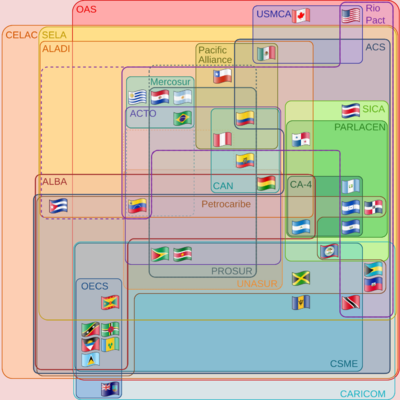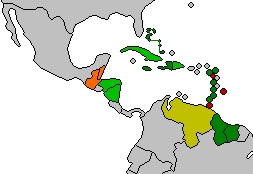Petrocaribe facts for kids
| Public | |
| Industry | Oil |
| Founded | June 2005 |
| Headquarters | ? |
| Products | Oil |
| Revenue | |
|
Operating income
|
|
| Parent | PDVSA |
Petrocaribe was a special agreement about oil between Venezuela and many countries in the Caribbean region. It was started on June 29, 2005, in Puerto La Cruz, Venezuela. This happened when Hugo Chávez was the president of Venezuela.
Under this agreement, Venezuela offered to sell oil to these countries at a very good price. They also offered easy ways to pay for it. Petrocaribe was part of a bigger idea in Latin America to help countries work together. It aimed to improve their economies and help them develop.
In 2013, Petrocaribe started working closely with the Bolivarian Alliance for the Americas (ALBA). This was to do more than just trade oil. They wanted to encourage economic cooperation between member countries. However, the agreement mostly ended by 2019. This was due to Venezuela's oil production going down. Also, problems like corruption and changing oil prices caused issues.
In November 2022, Saint Vincent and the Grenadines was the first country to start getting oil again under the Petrocaribe terms. In 2023, Venezuela said it wanted to restart the whole program.
Contents
What Was the Petrocaribe Agreement?
The Petrocaribe agreement was created to show support for other countries. It was based on the ideas of the Bolivarian Alliance for the Americas. The agreement allowed countries to buy oil at its normal price. But they only had to pay a small part (5% to 50%) upfront.
They also got a special grace period of one to two years before paying more. The rest of the money could be paid over 17 to 25 years. The interest rate was very low, only 1%, if oil prices were above US$40 per barrel. This deal was similar to older agreements like the San José Agreement.
Rafael Ramírez, who was in charge of oil for Venezuela, said the deal was about helping countries directly. He explained that it was not about giving discounts. Instead, it was about making payments easier and delivering oil straight to countries. It also helped avoid extra costs from middlemen.
Which Countries Were Members?

Petrocaribe had 18 member countries in total. These included Antigua and Barbuda, Bahamas, Belize, Cuba, Dominica, Dominican Republic, Grenada, Guatemala, Guyana, Haiti, Honduras, Jamaica, Nicaragua, Saint Kitts and Nevis, Saint Vincent and Grenadines, Saint Lucia, Suriname, and Venezuela.
Twelve of these members were also part of the Caribbean Community (CARICOM). When Petrocaribe first started, 14 countries joined. These were Antigua and Barbuda, the Bahamas, Belize, Cuba, Dominica, Grenada, Jamaica, Saint Lucia, Saint Kitts and Nevis, Saint Vincent and the Grenadines, Suriname, and Venezuela.
Later, Haiti and Nicaragua joined the group. Guatemala became a member in July 2008. However, Guatemala left in November 2013. They said Venezuela had not given them the very low financing rates they were promised.
Haiti was not invited at first because Venezuela did not recognize its government at the time. But Hugo Chávez worked to get René Préval, Haiti's new president, to join. Venezuela invested in building things in Haiti. After this, Haiti received its first oil shipment in March 2008.
Honduras joined in December 2007 when Manuel Zelaya was president. But Honduras left after a change in government in 2009. They rejoined the organization in May 2012. Belize created a company called the Belize Petroleum Energy Company to manage its part in the project.
Countries That Did Not Join
Barbados said it did not join because of pressure from the United States. The U.S. has had a difficult relationship with Venezuela. However, Barbados did not say it would never join Petrocaribe. In August 2005, Barbados's Energy Minister, Anthony Wood, said they were still thinking about it. In April 2011, Venezuelan president Hugo Chávez again offered Barbados a chance to join.
Panama asked to join Petrocaribe in March 2009. They initially said they would join even with a new president. However, Panama never became a member.
Important Meetings (Summits)
The first meeting, or summit, that started Petrocaribe was in Puerto La Cruz, Venezuela. The second summit was held in Montego Bay, Jamaica. The third summit took place in Caracas, Venezuela. The fourth summit was in Cienfuegos, Cuba, in December 2007.
The seventh summit was held in Caracas on April 6, 2013. At this meeting, Honduras rejoined Petrocaribe after being suspended. Guatemala also officially became a new member. The summit also discussed working more closely with ALBA countries. They talked about tourism, air travel, and making sure there was enough food for everyone. The 11th Summit was held in Port-au-Prince, Haiti.
What Happened Recently?
By 2019, Petrocaribe had mostly stopped working. This was because Venezuela's own oil production had greatly decreased. Also, its oil refining abilities were not as good. However, some political and business connections from the agreement still remained.
Some people say Petrocaribe stopped countries from developing cleaner energy sources. They also say it caused these small nations to owe billions of dollars. It also led to corruption. Venezuela's oil industry is currently facing many challenges. In 2014, Venezuela's oil rigs produced almost 3 million barrels of oil each day. Now, they produce less than a million barrels daily.
Besides Venezuela's economic problems, the U.S. put sanctions on the country. This made it very hard to send bank payments to Venezuela. The only country still getting oil from Venezuela with special payment terms is Cuba. Cuba does not have debt problems from this oil. This is because Cuba agreed to pay for its oil by sending doctors to Venezuela.
In 2022, Saint Vincent and the Grenadines received oil from Venezuela under the Petrocaribe terms. This made it the first country to restart Petrocaribe ties. In 2023, Venezuela announced it plans to bring Petrocaribe back. In July 2023, CARICOM members asked the U.S. to remove its sanctions on Venezuela. This would allow them to buy oil under the good terms of Petrocaribe again.
See Also
- SUCRE (currency)
- History of Venezuelan Oil Industry
- Petróleos de Venezuela, S.A.


